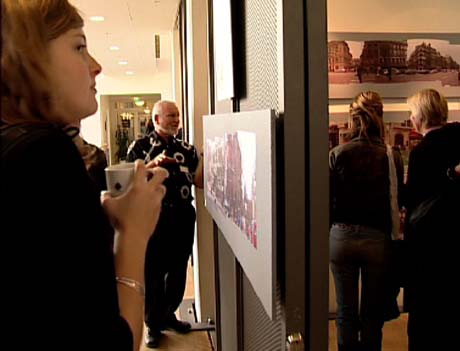The Exhibition ‘Speaking places, places speaking’ were presented at a small exhibition room at the Roskilde University in relation to a research seminar dealing with gazes on the specific site of Paris trying to reveal more than the ordinary from a popular site.
The whole project had generated sixteen large photographs but for this exhibition, only seven of them were selected to present the variety of the basic idea namely what can be called Parisian or French? This quest for identity was contrasted to the photographic document of the 1950ties and the golden age of after-war epoch.

CONCEPT
To find out what Paris is, this project scrutinises the analysis of the place that leads to the creative production of the exhibition, i.e. the city, and the process of production. The main idea is to transform the complexity of the city and the place into something more manageable like a picture. In this respect the visual becomes more than just communication or something aesthetic to be looked at; the visual becomes a new analytical tool to undertake what I term a transvisual analysis. ‘Trans’ stands for ‘transformative’, namely to follow this picture-on-picture-on-picture process, i.e. Paris as a place, and then adds a new layer that involves analysing the physical place as an image, namely that a natural visual environment has to be transformed into an image.
The goal of the transvisual analysis is to discover Paris by ignoring the well-known places that have turned the city streets into a museum and to explore the more anonymous non-places. My starting point is a map of Paris, which I happened to get from a travel agent, which appears to be sponsored by McDonald's. So, we have America in Paris.
There are numerous red squares on the map indicating where there is a McDonald’s restaurant. I arbitrarily decide that I will photograph 16 different McDonald’s. Consequently, I now know where the camera should stand.
2) Visual rules
The visual rules clarify how I am going to do the photographs and how the images are going to be used and installed. The four general rules I create are:
a) The timeframe for taking the photographs of the 16 McDonald’s is one week. I choose them based on two criteria. They must be geographically dispersed across central Paris and they must represent a mixture of places comprising well-known Parisian sites, monuments and buildings and non-descript, neutral sites.
b) I want to photograph each McDonald’s using a digital camera that can take 3 to 6 images to create a panorama photo. The time of day will be randomly selected; the quality of the daylight, depending on weather and time of day, will be unpredictable; the available scenarios will also be variable as will the temporal trajectory in the photograph, where the 3-6 pictures will be taken over several minutes at different intervals.
c) The images from each site will be later processed and put together using a digital program to form one coherent photograph. The edge of each picture will be visible, making it possible to see where one photo ends and the next one begins.
d) Contrary to drawings and paintings, photographs have no solid, original size. I decide that the amalgamated panorama photos should have a print size of 38x100-220 cm; most of them end up being about 150 cm wide. The size will afford viewers a unique opportunity for studying the pictures. The 16 large panoramic photos will be exhibited as a contemporary art project. The aesthetic relationships are open to further investigation by the visitors, because of the pictures’ spatial presentation within a narrative structure in an exhibition.
The transvisual method is an ongoing learning process. Through my analysis I demonstrates that there is the potential to learn more at goal-orientated, well-defined museum and exhibition surroundings. The first step is that visual production must be acquired to produce photos and videos, but even more important is having the opportunity to produce a visual event like “… an interaction of visual sign, the technology that enables and sustains that sign, and the viewer” (Mirzoeff 1999:13).
If the social production of form and content is taken seriously, committing more time and effort to entering into a close relationship and transformation involving the visual is necessary and must be presented clearly, which also allows the creation of a foundation for tacit learning.
This project is analysed in depth in Ingemann, Bruno (2012): Present on Site. Transforming Exhibitions and Museums. (forthcomming)